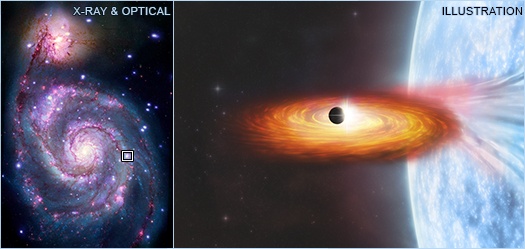Discovery of the first exoplanet candidate in X-ray binary M51-ULS-1 in the spiral आकाशगंगा Messier 51 (M51), also called the Whirlpool आकाशगंगा using transit technique by observing dips in brightness at X-ray wavelengths (instead of optical wavelengths) is pathbreaking and a game changer because it overcomes the limitation of observation of dips in brightness at optical wavelengths and opens up the avenue for the search of exoplanets in external galaxies. Detection and characterisation of ग्रहों in external galaxies has significant implications for search for extra-terrestrial life.
“लेकिन सब कहाँ हैं?” Fermi had blurted out, way back in the summer of 1950, pondering why there is no evidence of any extra-terrestrial life (ET) out in the अंतरिक्ष despite high probability of its existence. Three quarters of the century past that famous line, still there is no evidence of any life anywhere outside the Earth, but the search continues and one of the key components of this search is the detection of ग्रहों outside the solar system and its characterisation for possible signatures of life.
4300 ओवर exoplanets पिछले कुछ दशकों में खोजे गए हैं जिनमें जीवन का समर्थन करने के लिए उपयुक्त स्थितियां हो भी सकती हैं और नहीं भी। वे सभी हमारे घर के भीतर पाए गए आकाशगंगा। नहीं exoplanet was known to be discovered outside the Milky Way. In fact, there is no evidence to support the idea of presence of planetary system in any external आकाशगंगा.
वैज्ञानिकों ने अब एक संभावित खोज की सूचना दी है exoplanet candidate in an external आकाशगंगा for the first time. This extrasolar ग्रह is in the spiral आकाशगंगा Messier 51 (M51), also called the Whirlpool आकाशगंगा, situated at a distance of about 28 million light years away from home आकाशगंगा आकाशगंगा.
आमतौर पर, ए ग्रह is detected by way of observing eclipse it produces when it transits in front of its सितारा जब परिक्रमा around thus blocking the light emanating from the सितारा (transit technique). This event is observed as temporary dimming of the star. Search for an exoplanet involves searching for dips in the light of a सितारा. The other method of detection of ग्रहों is by radial velocity measurements. All exoplanets have been detected using these techniques in our home galaxy at relatively short intra-galactic distances in the range of 3000 light years.
However, searching for dips in the light at larger inter-galactic distances to detect exoplanets outside the Milky Way is an uphill task because an external galaxy occupies a small area in the sky and the high density of सितारों does not allow study of an individual star in sufficient details to enable detection of signatures of a ग्रह. As a result, search at optical wavelength in an external galaxy was not feasible until now and no exoplanet outside our home galaxy could be discovered. The latest research is pathbreaking and a game changer because it seemingly overcomes this limitation by observing dips in brightness at X-ray wavelengths (instead of optical wavelengths), and opens up the avenue for the search of exoplanets in other galaxies.
X-ray binaries (XRBs) in the external galaxies are considered to be ideal for the search of exoplanets. These (i.e., XRBs) are a class of binary सितारों made up of a normal star and a collapsed star like white dwarf or a काला छेद. जब तारे काफी करीब होते हैं, तो सामान्य तारे से सामग्री गुरुत्वाकर्षण के कारण सामान्य तारे से घने तारे की ओर खींची जाती है। नतीजतन, घने तारे के पास जमा सामग्री अत्यधिक गर्म हो जाती है और एक्स-रे में चमकदार एक्स-रे स्रोतों (एक्सआरएस) के रूप में दिखाई देने लगती है।
With an idea to detect ग्रहों परिक्रमा X-ray binaries (XRBs), the research team searched for dips in the brightness of X-ray received from the bright X-ray binaries (XRBs) in three external galaxies, M51, M101, and M104.
टीम ने अंततः एक्स-रे बाइनरी M51-ULS-1 पर ध्यान केंद्रित किया जो M51 आकाशगंगा में सबसे चमकीले एक्स-रे स्रोतों में से एक है। चंद्रा दूरबीन द्वारा प्राप्त एक्स-रे की चमक में गिरावट देखी गई। विभिन्न संभावनाओं के लिए चमक में गिरावट के बारे में डेटा की जांच की गई और एक ग्रह द्वारा पारगमन के लिए उपयुक्त पाया गया, जो कि शनि के आकार की सबसे अधिक संभावना है।
This study is also novel for carrying out the search of exoplanets successfully for the first time at X-ray wavelength. On the broadest level, this landmark discovery of exoplanet outside our home galaxy expands the scope of search of exoplanets to other external galaxies, which has implications for the search of extra-terrestrial intelligent life.
***
सूत्रों का कहना है:
- डि स्टेफानो, आर।, बर्नडट्ससन, जे।, उर्कहार्ट, आर। एट अल। एक्स-रे ट्रांजिट के माध्यम से बाहरी आकाशगंगा में एक संभावित ग्रह उम्मीदवार का पता चला। नेचर एस्ट्रोनॉमी (2021)। डीओआई: https://doi.org/10.1038/s41550-021-01495-w. ऑनलाइन भी उपलब्ध है https://chandra.harvard.edu/photo/2021/m51/m51_paper.pdf. प्रीप्रिंट संस्करण पर उपलब्ध है https://arxiv.org/pdf/2009.08987.pdf
- नासा। चंद्रा एक और आकाशगंगा में संभावित ग्रह के साक्ष्य देखता है। पर ऑनलाइन उपलब्ध है https://chandra.harvard.edu/photo/2021/m51/
- नासा। विज्ञान-वस्तुएं - एक्स-रे बाइनरी सितारे। पर ऑनलाइन उपलब्ध है https://imagine.gsfc.nasa.gov/science/objects/binary_stars2.html
- श्वीटरमैन ई., कियांग एन., एट अल 2018 एक्सोप्लैनेट बायोसिग्नेचर: जीवन के दूर से पता लगाने योग्य संकेतों की समीक्षा। एस्ट्रोबायोलॉजी वॉल्यूम। 18, नंबर 6. 1 जून 2018 को ऑनलाइन प्रकाशित। डीओआई: https://doi.org/10.1089/ast.2017.1729






































